
Engagement is one of the most important metrics for any social media profile; it determines how much your audience cares about your content and how connected they are with you.
In a Facebook Group, engagement is even more important because it is a direct measure of the value of the group for its members, and the higher the value your group brings, the more likely Facebook is to recommend it to new members.
Unlike Facebook Pages or other social media platforms where content flows “one way” (that is, you post and your audience interacts with that content), calculating your Facebook Group’s engagement rate is not as obvious because content and discussions are “many to many” and engagement can come in many ways.
In this article, we will discuss why your Facebook Group engagement rate matters, how to calculate it and how to compare it with others in our benchmark so you can understand if your group engagement rate is as expected or it can be improved.
Why you want your Facebook Group to be engaged
Almost every Facebook Group admin will seek to promote engagement in their group, but have you ever stopped to wonder why that is important?
There are many reasons why this is a relevant metric and below is a list of the most important ones:
- Highly engaged groups get recommended more by Facebook so they grow faster. Watch any of our Facebook Group Talk Show and you will hear them all say this.
- Engaged and high quality groups appear higher in the search results when members look for potential groups to join.
- Engaged groups are early beta testers of new Facebook Group features and their groups benefit from new features being rolled out earlier than others.
- Engaged groups enjoy higher levels of trust and promote a deeper sense of connection, sparking connections between members.
- Engaged groups appear more often on members’ feed and remain more top of mind, so they are more likely to be recommended to friends.
- A highly engaged group will give the Community Leader or brand running it, a higher level of success and authority, which is one of the reasons to start a Facebook Group, while a passive group with little engagement will do nothing for a brand.
- Facebook’s algorithm is more likely to promote content from a highly engaged group over content from a group is not very engaged in user’s feed, creating an engagement cycle (content is shown to more members, so more of them react and contribute, thus pushing the content to be shown to more members, etc.).
- The more engaged your group is, the higher the probability that you will unlock the Group Support option so you can reach out to Facebook’s support team for any issues that may arise (though in our opinion the value of that is minimal at the time of writing because the support team is not equipped or empowered to actually help you and end up almost almost always simply escalating issues to technical support).
- Highly engaged groups have higher monetization potential (more eyeballs on the product / service you sell / promote).
As a result, highly engaged groups are more valuable to their members and to the admins who manage them. So, YES, you should promote engagement in your Facebook Group.
How to check your Facebook Group engagement rate
Let’s start by defining what we mean with engagement rate and how you can check where your group stands.
On any other platform, engagement rate of a post is usually calculated as the total reactions on that post divided by the total number of followers. Thus, an Instagram post with 1,000 likes on a profile with 10,000 followers will have an engagement of 10%.
However, on a Facebook group we don’t usually look at engagement on a per post basis, because there are many more posts per day than on a regular social media profile and they are not all posted by the admin. Instead, the engagement rate is calculated as a whole for the group.
We define the engagement rate of a group in two ways, by the percentage of active members (activity rate) and by the percentage of engagement over a period of time (engagement rate):
- Activity rate: The percentage of members in your group who are active in a certain period of time, usually a month, by either reading posts, reacting to content shared, posting or commenting. Facebook considers all four of these (including simply seeing your group’s content) as “activity” even though you could argue that those members who are simply reading the posts in the group are not really engaging from a literal stand point. This engagement rate can be measured from 0% to 100%.
- Engagement rate: The amount of reactions, comments, posts and contributions your groups members have made within your group in a specified period. This type of engagement is more important to us and talks about how engaged your members are, not about how many of them are engaged, and does not take into account silent members who do not engage with your content. In this case, engagement rates can go from 0% to well above 100%.
Both of the above metrics matter when understanding the engagement rate of your group and they should be read in conjunction when you assess your group’s quality. Looking at one metric alone will not tell you a complete picture of your group’s engagement rate.
How to check your activity rate
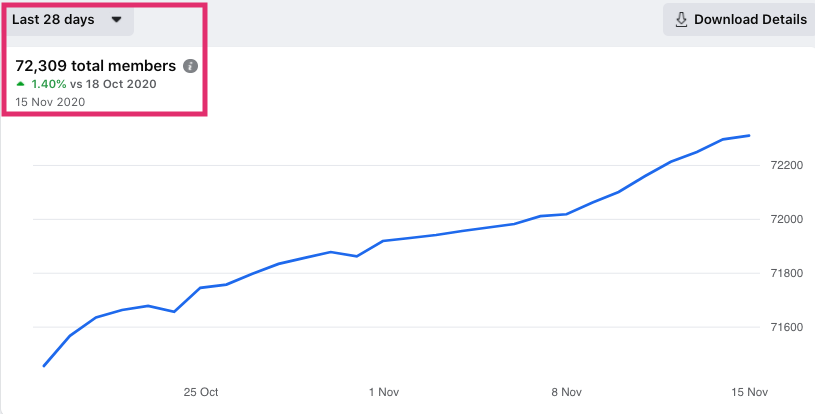
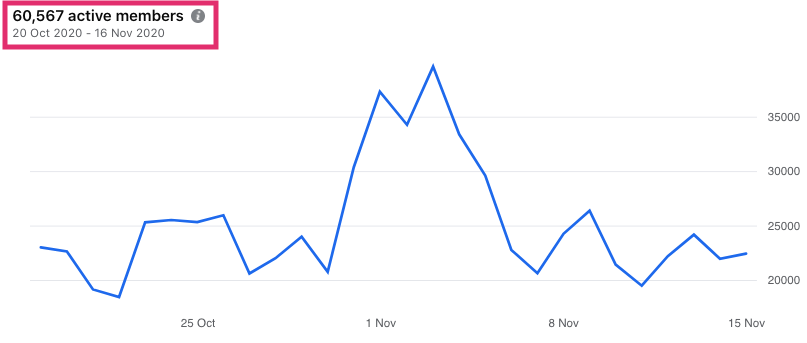
The activity rate is an easy to calculate number because Facebook shows you the number of members who have been active in your group and the total number of members in it.
To calculate the activity rate of your group, you should take the number of active members in the last 28 days and divide it by the average total number of members in the last 28 days.
Activity rate: Active no. of members in the last 28d / Average no. of members in your group in the last 28d
Looking at the above calculation, take note of the following:
- To calculate the average number of members in your group in the last 28 days you should take the number of members at the end of the 28 days period plus the number of members at the beginning of the 28 day period and divide it by two.
- If your group’s growth is low, taking the number of member at the end of the month will be fine, but if your group is in its hockey-stick growth period, you should consider the average for the last 28 days instead of the number of members at the end of the month.
How to check your engagement rate
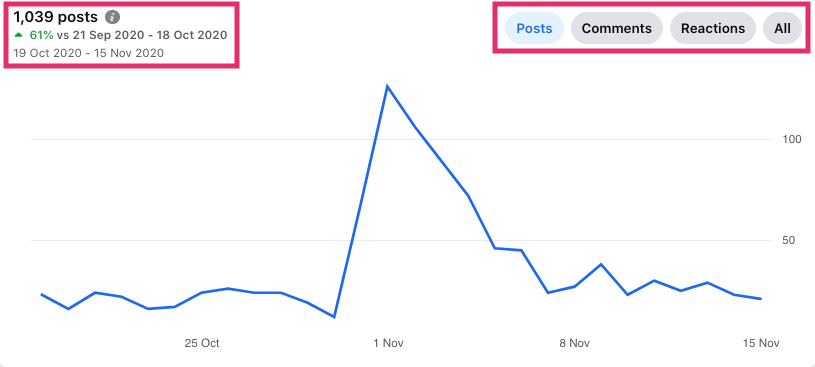
To calculate engagement rate, you should add all the comments, posts and reactions in your group in the last 28 days and divide them by the average number of active members in your group from the above calculation (end of period active members plus beginning of period active members divided by two).
Engagement rate: (no. of comments + no. of reactions + no. of posts) / Average no. of active members in your group in the last 28d
Looking at the above calculation, take note of the following:
- We use active members and not total members here. This is because we want to isolate the engagement level of a group independent from its activity level. For example, if you had 10 members who generated 21 actions in the last 28 days, but only 7 were active you would have an activity rate of 70% and an engagement rate of 300%. If you calculated the engagement rate over the total number of members, your engagement rate would just be 200%.
- Our calculation gives the same weight to a reaction than to a comment or a post and in reality, the effort and engagement shown by a member who posts is higher than those who comment or react to a post. For example, a group with 100 post and 50 comments and reactions is more value-engaged than a group with 20 posts and 130 reactions. If you wanted to make the calculation more precise for your own tracking, you could give different weights to the 3 types of interactions, for example, by multiplying the number of posts by 3, the number of comments by 2 and counting reactions as is, then adding the total figure afterwards. You should then track this figure over time for a more accurate assessment of how you are doing.
Learn Our Secrets to Growing 15 Groups to 100k + Members! Get Our E-Book!
400 + Actionable Pages
390 + How-to Screenshots
32 Proven Unpaid Growth Strategies
My group has exploded using your strategies. A competing group actually asked me how I was growing so quickly!!

Comparing you Facebook Group engagement rate
Facebook considers a group with an activity level of 80% to be very highly engaged, so if your group is at that level you are getting top marks and are probably unlocking some of Facebook’s recommendations algorithm already.
Our groups have an activity level of between 85-95% depending on the group, and this is not by chance, it is because we provide the right atmosphere for the groups to thrive and because we foster conversations and interactions between members. We are also prompt at removing spam and inactive members when possible so we clean up the membership.
In order to understand what is an average activity and engagement rate, we compiled benchmark figures from 40 groups from across the world and across niches.
What is a good activity rate for your Facebook Group?
Below is a histogram that shows a benchmark of activity level from expert Community Leaders in our community averaged by the group size in number of members:
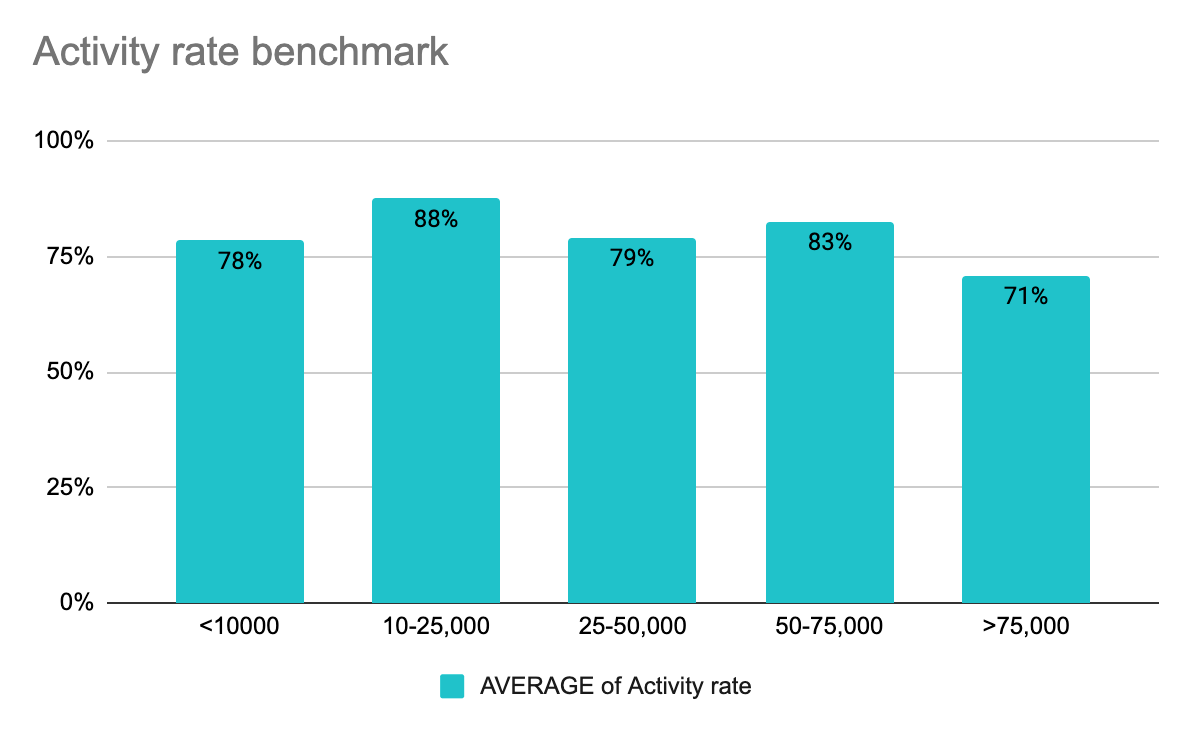
As you can see, most groups have an activity level between 70-95% depending on the size.
As a rule of thumb, you should expect smaller and more specific groups to be more active than larger and more general ones, that is just because the stronger the affinity your members have with your group, the more likely they are to keep coming back to it.
Additionally, smaller groups are less likely to cloak someone’s feed, and ending up being hidden or unfollowed because of that.
What activity rate should you aim for?
We would recommend aiming for a high figure of 80% and above.
Having a high percentage of your members disengaged from your group and not even reading your content does not help your group’s overall quality and potential for recommendation by Facebook. Inactive members are dragging your group down.
Sadly, Facebook does not give you a tool to remove inactive members and even what they call Inactive members is not really made of members who are not interacting or visiting your group but rather:
- Members who blocked the Admin.
- Accounts that are inactive on Facebook.
- Accounts that are suspended on Facebook, including temporarily.
- Accounts that are Locked.
Why we do not aim for a 100% activity rate?
It is normal that a percentage of your members will lose interest in your group in a given month, tune off and take care of other things and then return the next or when there is a topic that is of relevance to them so aiming for 100% is an ambitious goal but one that is probably unattainable.
Below is a list of other elements that influence the activity level of your group:
- The topic of your group: Some group topics touch a person’s daily life and are built around a lifestyle (dieting, exercise, sports, etc.) so they are more likely to have a higher activity rate, whereas others focus on seasonal topics (eg. FIFA, family holidays, Christmas, etc.) that come and go in importance as the year progresses. Some groups are even set up for a specific temporary need (eg. travel groups to a destination aimed at helping travelers plan a trip) which may be solved and the interest in the group disappear and with it.
- Your growth strategies: How your members came to know you and join your group also influences your group’s activity levels. If you have hosted lots of Facebook contests or if you have grown your group in ways which may have attracted members who joined for reasons beyond the intrinsic value of a group (e.g a challenge, a live session, a training, etc.) you are more likely to have inactive members once that need is fulfilled.
- The consistency of your group appearance and content: If your group’s name, description or cover image are not aligned with your group’s content you may attract the wrong kind of members who may leave straightaway or stay and become inactive. Having a short or not very descriptive about page may attract members who are curious and then realize the group is not for them. Some will take steps to leave, others will simply turn off notifications.
- Whether you have post approval on: If you don’t have post approval on you will undoubtedly have more posts published on your feed than if you turn it on and catch anything that is against the group’s rules.
- How easy it is to join your group: Groups without any restrictions on membership have no barrier to entry and this will grow faster, but are more likely to attract the wrong kind of member who may quickly become inactive.
What is a good engagement rate for your Facebook Group?
Now that we know more about a group’s activity rate, we will look at a group’s engagement rate. Below is a histogram that shows a benchmark of engagement rates by group size based on groups in our community:
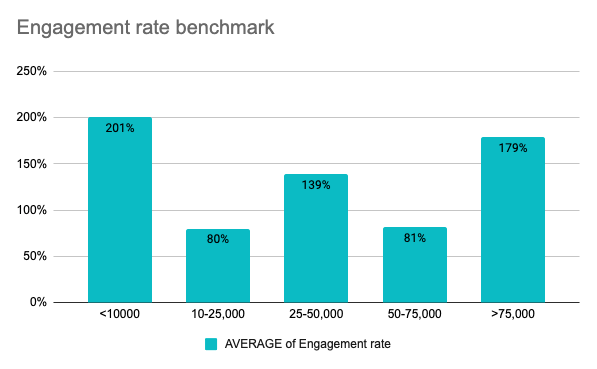
As you can see, smaller groups are also much more engaged whereas that rate decreases with size, just like in the case of activity. There are a few additional learnings and insights we can extract from the above benchmark graph:
- It is very difficult to set a benchmark for engagement rate within a Facebook Group because there are many elements that play a role in this figure and we recommend that this figure be assessed in conjunction with the activity level and with an understanding of your business.
- In general, we would expect engagement rate to be well above 100% and anything below that to be poor engagement. This is because if the number of reactions, comments and posts is equal to less than 1 per active member on average, that is a symptom of the group having an engagement issue. However, this may not always be symptomatic of an issue and reaching this conclusion needs to be the result of an assessment that also looks at the activity rate, the group type, the age, the strategies used to grow the group, the seasonality, the topic, etc.
Below are some other elements that can impact the engagement rate of a group:
- A group’s size. The larger a group is the more likely it is to have members who are only tangentially interested in the topic and are more inclined to be “observers” rather than active participants. Having members who don’t contribute should be seen as an opportunity: if you publish the right type of content they may become active participants.
- The amount of beginners in your group: If your group is open to members who are not yet users of the product, service or idea your group is about and are still deciding, you may find a higher percentage of members who don’t engage. They may be in the group simply reading the content rather than actively participating in the discussions and this will be obvious when you compare the activity rate (which should be high) and the engagement rate. This is not necessarily a bad thing as these members may convert into participants soon and when they do, they will contribute more to the discussions. To understand that, you could ask new joiners if they are users.
- The topic of your group: Some groups are made more for “consumption” than for participation. For example, groups for memes of jokes may have a small percentage of creators who share content with the group and a large percentage of consumers who simply watch the content. As we saw from the list of the largest and most popular Facebook Groups, some of these are consumption groups where a large percentage of the members simply consume the content without posting or participating in the discussions.
- How savvy your members are: There are all sorts of Facebook users among the 2.6 billion using the platform and some of them are savvier than others. Groups with savvy members are more likely to engage in deeper and multi dimensional ways like on Live videos, Rooms, Watch Parties, etc. pushing engagement level higher. Depending on the type of group you have chosen, you will also unlock features that may help with engagement, such as Anonymous posting or Mentorship.
- How broadly defined your group’s subject is: The more niche your group’s topic the higher the chance of your members having an affinity to the group. The broader the subject, the more likely the topics discussed are not always relevant to a large percentage of the members.
Learn Our Secrets to Growing 15 Groups to 100k + Members! Get Our E-Book!
400 + Actionable Pages
390 + How-to Screenshots
32 Proven Unpaid Growth Strategies
My group has exploded using your strategies. A competing group actually asked me how I was growing so quickly!!

Frequently asked questions about Facebook Group engagement
Because there is a strong correlation between an engaged group and a high value group. The higher the value of your group, the more likely Facebook is to recommend it to new members, the lower its churn and the higher the trust. All of this contributes to a higher return on investment for the admin.
If we define engagement as comments, posts and reactions in a group, engagement rate would be the number of comments + posts + reactions for an average active member in the last 28 days.
Engagement rate: (no. of comments + no. of reactions + no. of posts) / Average no. of active members in your group in the last 28d
If you calculate your engagement rate in terms of member activity, you should divide the average number of active members by the average number of total members in the last 28 days. We call this activity rate.
Activity rate: Active no. of members in the last 28d / Average no. of members in your group in the last 28d
If you define engagement as the % of members who are active in your group, we would define 80% and above as a good engagement rate. If you define engagement rate as the % of members who participate in your group, we would expect the rate to be well above 100% for a quality group.
We give tips to do that above, but in general, the most engaging content is highly relatable, easy to interact with, entertaining or controversial and published at the right times/days.


Yeah I know but I’m not very sure about my own schedule. I have sporadic timings.
Gardner78400@aol.com
Thank you for your article! It is the most comprehensive that I’ve seen.
My question is: How do you compute for average Active Members and average Total Members?
Thanks in advance!
Hi Vince, to compute the average you take end of the month + beginning of the month and diving by 2. So if you had 1000 members at the end of the month and 500 at the beginning, your average was 1000+500 = 1500 / 2 = 750. Hope this helps. Mar
Thanks, really enjoyed this article! Just to clarify a point to make sure I understand, for example…. So 416 posts+1674 comments+21598 reactions = 23688 For active members Facebook shows 7420 “Active Members” in the Group Engagement section. 23688/7420 = 3.19 x 100 = 319 so 319%? Calculated the other way 7420 (active members)/9164 (total members) = 0.809 or 81%? Is my math correct or did I miss something?
Hi Bill, yes, that math is correct – the members are contributing on average 3x each during the month and 81% are active 🙂
I’ve deleted all the unavailable group members. To raise my group ratios, should I purge the inactive group members who no longer contribute to the community?
I also continue to grow at a slow steady pace the same range of people each week
I’m curious, why would anyone need to buy this book? My engagement has always been 90% and the engagement rate 600%. ALL LEAPS AND BOUNDS over the benchmarks that are listed in this website